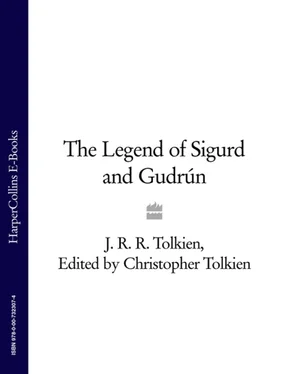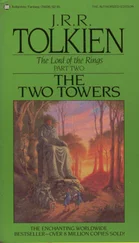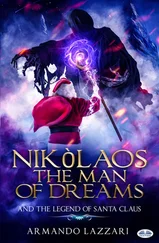J. Tolkien - The Legend of Sigurd and Gudrún
Здесь есть возможность читать онлайн «J. Tolkien - The Legend of Sigurd and Gudrún» — ознакомительный отрывок электронной книги совершенно бесплатно, а после прочтения отрывка купить полную версию. В некоторых случаях можно слушать аудио, скачать через торрент в формате fb2 и присутствует краткое содержание. Жанр: Старинная литература, на английском языке. Описание произведения, (предисловие) а так же отзывы посетителей доступны на портале библиотеки ЛибКат.
- Название:The Legend of Sigurd and Gudrún
- Автор:
- Жанр:
- Год:неизвестен
- ISBN:нет данных
- Рейтинг книги:5 / 5. Голосов: 1
-
Избранное:Добавить в избранное
- Отзывы:
-
Ваша оценка:
- 100
- 1
- 2
- 3
- 4
- 5
The Legend of Sigurd and Gudrún: краткое содержание, описание и аннотация
Предлагаем к чтению аннотацию, описание, краткое содержание или предисловие (зависит от того, что написал сам автор книги «The Legend of Sigurd and Gudrún»). Если вы не нашли необходимую информацию о книге — напишите в комментариях, мы постараемся отыскать её.
The Legend of Sigurd and Gudrún — читать онлайн ознакомительный отрывок
Ниже представлен текст книги, разбитый по страницам. Система сохранения места последней прочитанной страницы, позволяет с удобством читать онлайн бесплатно книгу «The Legend of Sigurd and Gudrún», без необходимости каждый раз заново искать на чём Вы остановились. Поставьте закладку, и сможете в любой момент перейти на страницу, на которой закончили чтение.
Интервал:
Закладка:
UPPHAF
This prelude to the Lay of the Völsungs echoes and reflects the most famous poem of the Edda, the Völuspá , in which the Völva, the wise woman or sibyl, recounts the origin of the world, the age of the youthful Gods, and the primeval war; prophesies the Ragnarök, the Doom of the Gods; and after it the renewal of the Earth, rising again out of deep waters (see the third part of my father’s poem The Prophecy of the Sibyl , given in Appendix B at the end of this book).
But the images of the Völuspá are here ordered to an entirely original theme: for the sibyl declares (stanzas 13–15) that the fate of the world and the outcome of the Last Battle will depend on the presence of ‘one deathless who death hath tasted and dies no more’; and this is Sigurd, ‘the serpent-slayer, seed of Ódin’, who is ‘the World’s chosen’ for whom the mailclad warriors wait in Valhöll (stanza 20). As is made explicit in my father’s interpretative note (iv) given on p.53–54, it is Ódin’s hope that Sigurd will on the Last Day become the slayer of the greatest serpent of all, Miðgarðsormr (see note to stanza 12 below), and that through Sigurd ‘a new world will be made possible’.
‘This motive of the special function of Sigurd is an invention of the present poet’, my father observed in the same brief text. An association with his own mythology seems to me at least extremely probable: in that Túrin Turambar, slayer of the great dragon Glaurung, was also reserved for a special destiny, for at the Last Battle he would himself strike down Morgoth, the Dark Lord, with his black sword. This mysterious conception appeared in the old Tale of Turambar (1919 or earlier), and reappeared as a prophecy in the Silmarillion texts of the 1930s: so in the Quenta Noldorinwa, ‘it shall be the black sword of Túrin that deals unto Melko [Morgoth] his death and final end; and so shall the children of Húrin and all Men be avenged.’ Very remarkably a form of this conception is found in a brief essay of my father’s from near the end of his life, in which he wrote that Andreth the Wise-woman of the House of Bëor had prophesied that ‘Túrin in the Last Battle should return from the Dead, and before he left the Circles of the World for ever should challenge the Great Dragon of Morgoth, Ancalagon the Black, and deal him the death-stroke.’ The extraordinary transformation of Túrin is seen also in an entry in The Annals of Aman, where it is said that the great constellation of Menelmakar, the Swordsman of the Sky (Orion), ‘was a sign of Túrin Turambar, who should come into the world, and a foreshadowing of the Last Battle that shall be at the end of Days.’ *
Beyond this, in the absence (so far as I know) of any other writing of my father’s bearing on his enigmatic conception of Sigurd, I think that speculation on its larger significance would fall outside the editorial limits that I have set for myself in this book.
My father’s Ódin does indeed retain his ancient character of gathering his ‘chosen’ to Valhöll to be his champions at the Ragnarök, and in the Lay of the Völsungs he appears against Sigmund, Sigurd’s father, and disarms him in his last fight, so that he is slain (IV.8–11). In Norse legend a belief is expressed that Ódin, faithless, ambiguous, and sinister, desiring strife among kinsmen, turning against his favourites at the last and felling those whom he has favoured, has reason for his conduct: he needs his own, needs his favourites against the day of the Ragnarök (see the note to IX.77–78).
But from the extraordinary complex of ideas that surround Ódin in Northern antiquity – suggesting layer upon layer of shifting belief and symbolism – a God is glimpsed in my father’s work who has retained little of the subtle, sinister, and enigmatic deity of ancient writings: the god of war, lord of the Valkyries; exciter of madness; the initiate, the lord of the gallows, the self-sacrificed, the master of obscene magic, the inspiration of poetry; the shape-changer, the old one-eyed man, the faithless friend, and on the Last Day the victim of the Wolf. ‘Weighed with wisdom woe foreknowing’ ( Upphaf 18), and seen by my father, referring to his own poem and to his treatment of the old legend, as symbolizing prudence and wisdom beside the malice and folly of Loki, Ódin seems more like Manwë of his own mythology; and he calls them both ‘Lord of Gods and Men’.
I On this stanza see p.246. It echoes the third stanza of the Völuspá ; and citing the Norse verse in a lecture my father followed it with this first stanza of the Upphaf , with some differences: ‘shivering waves’, ‘unraised heaven’.
II It is told by Snorri in the Prose Edda that Heimdal (Heimdallr) was the warden or sentinel of the Gods (Æsir), dwelling beside Bifröst (‘the quaking path’), the rainbow bridge between Ásgard, the realm of the Æsir, and Midgard, the world of Men (see note to 12), which he guards against the rock-giants; but at the Ragnarök (the Doom of the Gods) Bifröst will be crossed by the hosts coming from the fiery land of Múspell, and will break beneath them. The red part of the bow is blazing fire. Heimdal’s horn is the Gjallarhorn, whose blast is heard over all the worlds; and he will blow it at the Ragnarök.
The Ash is Yggdrasill, the World Tree, whose branches stretched out over earth and heaven. The Wolf is Fenrir (named in stanza 13), whom the Gods chained; but at the Ragnarök Fenrir will break his chains and devour Ódin.
12 Surt (Surtr) : the great demon of fire, at the Ragnarök coming out of Múspell, the land of fire, against the Gods.
The ‘slumbering Serpent’ is Miðsgarðsormr, the Serpent of Midgard, who lay coiled through all the seas encompassing Midgard, the world of Men. The Norse name Miðgarðr corresponds to Old English Middan-geard, Middan-eard, which lie behind the later form Middle-earth.
The ‘shadowy ship’ is Naglfar, made of dead men’s nails.
13 Frey (Freyr): the chief god of fertility, of peace and plenty, in Norway and Sweden; Freyja (stanza 17) was his sister.
The ‘deep Dragon’ is the Serpent of Midgard: see note on stanza 12.
I ANDVARA-GULL (Andvari’s Gold)
For the story in §I of the Lay of the Völsungs the sources are the Eddaic poem known as Reginsmál, the Lay of Regin, which is indeed less a poem than fragments of old verse pieced together with prose; a passage in Snorri Sturluson’s version of the Völsung legend in the Prose Edda; and the Völsunga Saga. The few verses in Reginsmál that bear on this part of the narrative (dialogue between Loki and Andvari, and between Loki and Hreidmar after the gold had been paid over) are here and there a model for the Lay, but only lines 5–6 in stanza 8 are a translation (Andvari ek heiti, Óinn hét minn faðir).
Apart from this, Andvara-gull in the Lay is a new poem. It is very allusive, and deliberately so, and I give here in abbreviated form the course of the story as it is known from the prose narratives: for the most part the two versions differ little.
It is told that three of the Æsir, Ódin, Hœnir, and Loki, went out into the world, and they came to a waterfall known as the Falls of Andvari, Andvari being the name of a dwarf who fished there in the form of a pike (Snorri says nothing of Andvari at this point). At that place there was an otter that had caught a salmon, and was eating it on the river bank; but Loki hurled a stone at the otter and killed it. Then the Æsir took up the salmon and the otter and went on their way until they came to the house of a certain Hreidmar. Snorri describes him as a farmer, a man of substance, greatly skilled in magic; in the Saga he is simply an important and wealthy man; whereas in the headnote to this section of the Lay he is ‘a demon’.
Читать дальшеИнтервал:
Закладка:
Похожие книги на «The Legend of Sigurd and Gudrún»
Представляем Вашему вниманию похожие книги на «The Legend of Sigurd and Gudrún» списком для выбора. Мы отобрали схожую по названию и смыслу литературу в надежде предоставить читателям больше вариантов отыскать новые, интересные, ещё непрочитанные произведения.
Обсуждение, отзывы о книге «The Legend of Sigurd and Gudrún» и просто собственные мнения читателей. Оставьте ваши комментарии, напишите, что Вы думаете о произведении, его смысле или главных героях. Укажите что конкретно понравилось, а что нет, и почему Вы так считаете.












